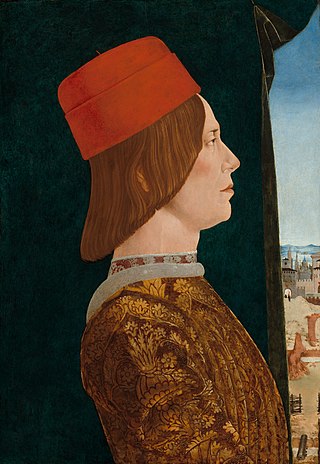
The House of Sforza was a ruling family of Renaissance Italy, based in Milan. Sforza rule began with the family's acquisition of the Duchy of Milan following the extinction of the Visconti family in the mid-15th century and ended with the death of the last member of the family's main branch, Francesco II Sforza, in 1535.

The 1490s decade ran from January 1, 1490, to December 31, 1499.
Year 1451 (MCDLI) was a common year starting on Friday of the Julian calendar.
Year 1481 (MCDLXXXI) was a common year starting on Monday of the Julian calendar).
The 1460s decade ran from January 1, 1460, to December 31, 1469.
Year 1473 (MCDLXXIII) was a common year starting on Friday of the Julian calendar.
The 1470s decade ran from January 1, 1470, to December 31, 1479.
The 1480s decade ran from January 1, 1480, to December 31, 1489.
The 1450s decade ran from January 1, 1450, to December 31, 1459.
Year 1480 (MCDLXXX) was a leap year starting on Saturday of the Julian calendar.
The 1420s decade ran from January 1, 1420, to December 31, 1429.
Year 1484 (MCDLXXXIV) was a leap year starting on Thursday of the Julian calendar, the 1484th year of the Common Era (CE) and Anno Domini (AD) designations, the 484th year of the 2nd millennium, the 84th year of the 15th century, and the 5th year of the 1480s decade.
Year 1482 (MCDLXXXII) was a common year starting on Tuesday of the Julian calendar.
Year 1455 (MCDLV) was a common year starting on Wednesday (full) of the Julian calendar.
Year 1443 (MCDXLIII) was a common year starting on Tuesday of the Julian calendar.

The House of Este is a European dynasty of North Italian origin whose members ruled parts of Italy and Germany for many centuries.

Vigevano is a comune (municipality) in the province of Pavia, in the Italian region of Lombardy. A historic art town, it is also renowned for shoemaking and is one of the main centres of Lomellina, a rice-growing agricultural district. Vigevano received the honorary title of city with a decree of Duke Francis II Sforza on 2 February 1532. It is famed for its Renaissance Piazza Ducale in the centre of the town.

Ludovico Maria Sforza, also known as Ludovico il Moro, and called the "arbiter of Italy" by historian Francesco Guicciardini, was an Italian nobleman who ruled as the Duke of Milan from 1494 to 1499.

Giovanni II Bentivoglio was an Italian nobleman who ruled as tyrant of Bologna from 1463 until 1506. He had no formal position, but held power as the city's "first citizen." The Bentivoglio family ruled over Bologna from 1443, and repeatedly attempted to consolidate their hold of the Signoria of the city.

Galeotto I Pico della Mirandola was an Italian condottiero and nobleman, Signore of Mirandola and Concordia. He was noted by contemporaries for his tyranny. The son of Gianfrancesco I Pico, Galeotto initially allied himself to the Duchy of Ferrara, first fighting for Duke Borso d'Este and then Ercole I d'Este, with whom he formed a strong bond. In 1486, he switched allegiance to Ludovico Sforza, Duke of Milan. He fought his brother Antonio for the Signoria of Mirandola. He was ultimately successful in the last battle, taking his brother's place in 1491, which was reaffirmed two years later. He died in 1499 and was succeeded by his son Giovanni Francesco.











